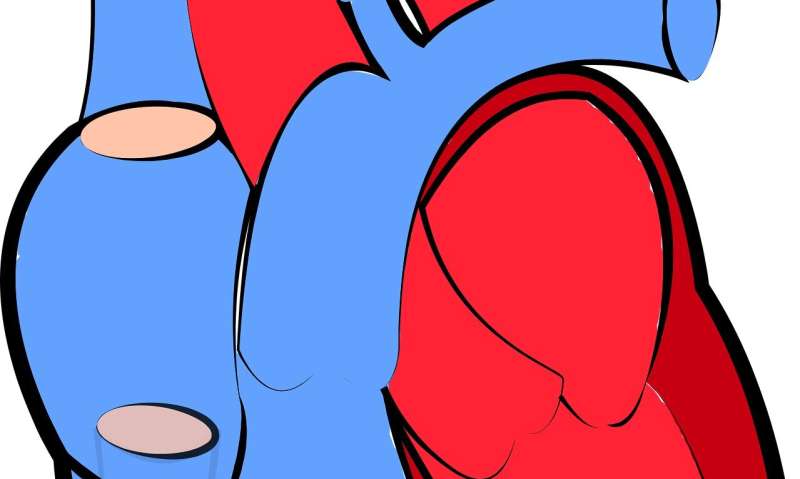This article has been reviewed according to Science X's editorial process and policies. Editors have highlighted the following attributes while ensuring the content's credibility:
fact-checked
peer-reviewed publication
trusted source
proofread
Alert banners dramatically increase prescribing rates of life-saving heart failure medication

An automated system that flags which patients could most benefit from an underused yet life-saving cardiology drug more than doubled new prescriptions, according to a pilot program test by researchers at NYU Grossman School of Medicine.
"Our findings suggest that tailored electronic notifications can boost the prescription of life-saving drugs," said study lead author and cardiologist Amrita Mukhopadhyay, MD, a clinical instructor in the Department of Medicine at NYU Langone Health. "By compiling key information in one place, the system may help providers to spend less time searching through medical records during a visit and more time speaking with their patients."
The trial applied the new tool to heart failure, the condition in which the heart is increasingly unable to pump enough blood. Medications called mineralocorticoid receptor antagonists (MRAs) can greatly increase survival rates, but past studies had shown that almost two-thirds of eligible patients are not prescribed these drugs. Other research has blamed this treatment gap for more than 20,000 preventable deaths each year in the United States.
According to the study team, part of the challenge in prescribing MRAs is that the medical information needed to determine a patient's eligibility is scattered throughout their electronic health record. As a result, experts have been exploring the use of digital messaging tools that automatically analyze standard clinical guidelines and relevant medical data to make treatment decisions easier.
The study is being presented at the annual conference of the American College of Cardiology (ACC) on March 5 and will be simultaneously published in the association's journal, JACC. According to the study authors, it is the first to directly compare the effectiveness of alert message types that address heart failure.
In the pilot program designed to find the most effective type of digital alert, researchers at NYU Grossman School of Medicine tested two automated technologies over six months that screened the records of more than 2,220 men and women in treatment for heart failure. The results showed that cardiologists who received a banner-like alert on their computer screen prescribed MRA therapy for about 30% of their patients over the course of the trial. Those who were instead sent monthly email-like messages did so roughly 16% of the time. By contrast, those who received neither type of message prescribed the therapy for 12% of their patients.
The research team tested the notification systems at more than 60 cardiology outpatient clinics within NYU Langone between April and October 2022. Adults with heart failure were randomly divided into three groups based on the type of support tool used by their cardiologist.
In the first group, alerts appeared on the top corner of patient healthcare charts, which are routinely reviewed during visits. They included data that could inform decisions around MRA therapy, such as blood pressure, estimated glomerular filtration rate (a measure of kidney function), and potassium levels in the blood.
Mukhopadhyay notes that the researchers aimed to avert overwhelming physicians with too many prompts. To prevent alarm fatigue, the alert was designed to exclude anyone who might be harmed by MRA treatment, such as those with certain kidney disorders, or who were already taking the medications.
For the second group of patients, cardiologists received a message each month that included a list of those eligible for MRAs. This system appeared similar to an email but was located within the healthcare system's internal messaging platform. Through this "email," healthcare providers could open medical charts and read information relevant for prescribing MRAs.
Those caring for patients in the final group received neither kind of notification.
"Even though monthly 'emails' limit interruptions during a consultation, alerts may be more effective because they allow physicians to discuss a recommended treatment in real-time," said study senior author Saul Blecker, MD.
Blecker, an associate professor in the Departments of Medicine and Population Health at NYU Langone, cautions that the technologies were only tested in cardiology practices within a large, urban healthcare system. As a result, Blecker says the team next plans to explore the effectiveness of these tools in other settings, such as primary care practices and smaller clinics.
In addition to Mukhopadhyay and Blecker, other NYU investigators involved in the study were Harmony Reynolds, MD; Lawrence Phillips, MD; Arielle Nagler, MD; William King, MS; Adam Szerencsy, DO; Archana Saxena, MD; Rod Aminian, MPH; Nathan Klapheke, BS; Leora Horwitz, MD; and Stuart Katz, MD.
More information: Amrita Mukhopadhyay et al, Cluster-Randomized Trial Comparing Ambulatory Decision Support Tools to Improve Heart Failure Care, Journal of the American College of Cardiology (2023). DOI: 10.1016/j.jacc.2023.02.005



















